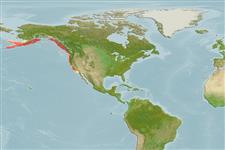Environment: milieu / climate zone / depth range / distribution range
Ökologie
seewasser demersal; tiefenbereich 0 - 780 m (Ref. 5515). Temperate; 59°N - 32°N
Eastern Pacific: Puffin Bay, southeastern Alaska to Santa Barbara Island, southern California, USA.
Size / Gewicht / Alter
Maturity: Lm ? range ? - ? cm
Max length : 29.0 cm TL Männchen/unbestimmt; (Ref. 2850)
Rückenflossenstacheln (insgesamt): 11; Rückenflossenweichstrahlen (insgesamt): 18-20; Afterflossenstacheln 0; Afterflossenweichstrahlen: 14 - 16; Wirbelzahl: 35. Dorsal deeply notched between third and fourth spine, and between spinous and rayed portions; caudal rounded (Ref. 6885). Color brown, often tinged with red on dorsal surface, mottled and barred with 4 dark saddles over dorsal surface (Ref. 6885).
Occurs in intertidal areas and down to at least 130 or 780 m depth (Ref. 5515). Usually found in subtidal areas of exposed coasts (Ref. 2850). Feeds on crustaceans (Ref. 6885).
Life cycle and mating behavior
Geschlechtsreife | Fortpflanzung | Ablaichen | Eier | Fecundity | Larven
Eschmeyer, W.N., E.S. Herald and H. Hammann, 1983. A field guide to Pacific coast fishes of North America. Boston (MA, USA): Houghton Mifflin Company. xii+336 p. (Ref. 2850)
IUCN Rote Liste Status (Ref. 130435)
Bedrohung für Menschen
Harmless
Nutzung durch Menschen
Mehr Information
ReferenzenAquakulturAquakultur ProfilZuchtlinienGenetikElectrophoresesVererbbarkeitKrankheitenVerarbeitungNutrientsMass conversion
PartnerBilderStamps, Coins Misc.LauteCiguateraGeschwindigkeitSchwimmstilKiemenoberflächeOtolithsGehirngrößeSehfähigkeit
Tools
Zusatzinformationen
Download XML
Internet Quellen
Estimates based on models
Preferred temperature (Ref.
123201): 3.8 - 8.1, mean 5.5 °C (based on 136 cells).
Phylogenetic diversity index (Ref.
82804): PD
50 = 0.5156 [Uniqueness, from 0.5 = low to 2.0 = high].
Bayesian length-weight: a=0.00676 (0.00300 - 0.01523), b=3.17 (2.98 - 3.36), in cm total length, based on LWR estimates for this (Sub)family-body shape (Ref.
93245).
Trophic level (Ref.
69278): 3.5 ±0.50 se; based on food items.
Widerstandsfähigkeit (Ref.
120179): niedrig, Verdopplung der Population dauert 4,5 - 14 Jahre. (Preliminary K or Fecundity.).
Fishing Vulnerability (Ref.
59153): Low vulnerability (19 of 100).
